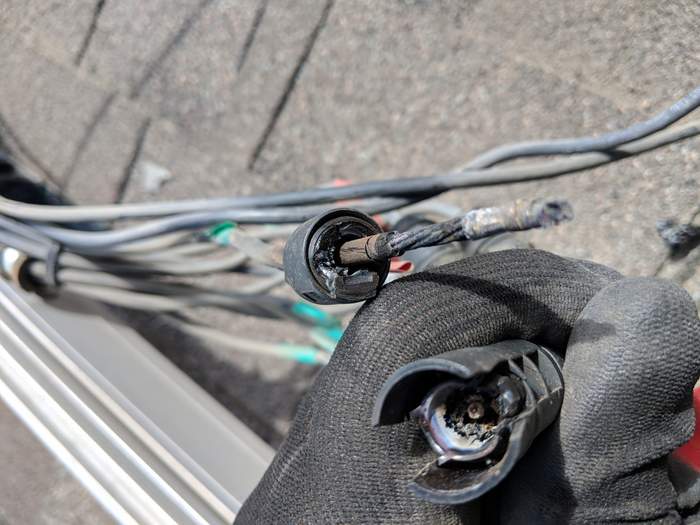Scott Carman of Paragon Solar routinely sees burned out solar module connectors. Previously a solar installer, Carman has shifted to solely doing O&M work, which usually means replacing broken panels (they get a lot of hail in Colorado). Many of these jobs involve stranded systems installed by companies now out of business. It is during these “R&R” jobs to replace busted panels that he finds burned out connectors, just by happenstance. Using some back-of-the-napkin math, he guesses that for every 100 calls, he’ll come across four or five of these burned out connectors.
“My concern is that we primarily find two types of failures with potential to cause a hazard, burnt out backsheets and connectors that have failed,” he says. “Connectors are one of the most common failure points we come across, and we are starting to see this more often.”
“I feel that the well intentioned additions to the rapid shutdown code tripled the number of connectors in a system, inadvertently creating more of a safety hazard it was meant to improve. The safest roof for a firefighter after all is the one they never were required to be on,” Carman says. “Another portion of the code directly related to this states that a single module on a device such as an optimizer or microinverter is not required to monitor the quality of the connectors. More specifically, under 80VDC AFCI is not required despite the fact that 40VDC and lower can easily cause a arc.”
Here’s a melted connector Carman comes across regularly. This was a single module (on a optimizer) that melted this connector and was not required to detect the arc that was creating it as it was only ~40V.
On the one hand, yes, that is the perspective of one person in one little corner of the country. But on the other hand – wow – that is just one guy in one corner of the country. And there is a growing group of veteran solar installers who are concerned this anecdote is more of a widespread trend that will only get worse unless there are changes made to NEC 690.12 concerning module-level rapid shutdown.
In fact, they’ve started a petition to request changes be made, and at press time, over 350 solar pros have signed it. You can check it out here.
Petitioners speak out
Why is NEC 690.12 in their crosshairs? As we’ve pointed out many times, to meet this safety code, solar installers are all but required to install some form of module-level power electronics (MLPE). The entire point is allegedly to give first responders peace of mind, but the petitioners point to several reasons why NEC 690 has not only not accomplished this, but has just made their jobs harder and riskier overall, by:
1) Increasing the number of failure points in every system
2) Adding electronics on the roof — which means more noise on the DC line, which affects arc fault detection and compromises the reliability of the shutdown function in the first place, as Carman noted (again, not adding safety for first responders).
3) Increasing costs for their customers.
“There is a place for optimizers for sure, on sites with partial shading, and we do install some, but I can save my customers a lot more money by not having to put that $130 piece of equipment on the back of everything,” says Jason Eiseman, sales manager at Wellspring Components, LLC. His company has been installing solar for 26 years and a majority of those are off-grid, battery-based systems.
We’ve written about the other products that also handle module-level shutdown, but this isn’t a matter of technology preference or just the gripes of installers trying to skimp on a system to make an easy buck. Their issue is the code presents a false choice by narrowing their options in the first place.
“I am able to install a comparatively cheaper product, but it still involves all of those connections up there and adds more points of failure,” Eiseman says. “I’ve always been of the mindset to keep it simple. A big goal of solar is to be more economical, and you can’t do that if you’re spending way more for the system than what you have to.”
To some, this might just sound like old school installers shaking their fists at clouds. Post-NEC 2017, the market immediately and dramatically shifted to MLPE with SolarEdge and Enphase making up more than 92 percent of the residential inverter market at last glance. Obviously not everyone in that majority is doing so against their will to meet NEC 2017.
“To be clear, I do not think optimizers or micros shouldn’t be used — I just don’t think they should be required by code,” Carman says.
“I know people don’t want a change – I mean, we just standardized on this! So I get that, but our issue is the standard needs to be more open,” says Phil Teague, co-founder and CEO of Rectify LLC. “If we’re going to make a transition to clean energy, we really need to have solution that’s as safe as possible and cost effective.”
What do they recommend instead?
The petition’s requests reveal what they’d like to see available in the market as a preferred solution: PV modules with the shutdown component embedded in the J-box to keep everything at string level.
- Request 1: Revert NEC 2020 690.12 (Module Level Shutdown) to NEC 2014 690.12 (Array Level Shutdown) requirements until proper solutions are available on the market, such as module-integrated, chip-based devices with an open industry standard.
- Request 2: Revert to NEC 2014 690.12 but keep the 1′ array boundary. “This way you’d have the power to more easily disconnect the system. Instead of needing each module to disconnect, the entire array would be discharged and grounded down,” Eiseman says.
- Request 3: Implementing a maximum electrical noise level requirement for rapid shutdown devices in 690.12.
- Request 4: Require 690.11 (Arc Fault Circuit Protection) to apply to all solar PV DC circuits, not just those above 80V, to detect any potential fire safety issues.
“Arc faults can happen at less than 80 volts,” Eiseman says. “Hell, it can be less than 20 volts, and it can be hot enough to burn the plastic connector and the wire itself. The J-box is a great place to kill the DC power in the event of an arc fault, and it also applies to all of our off grid systems. You have a lot of people getting into the solar market or DIY guys trying to install these, and it will be safer for them. That’s where the onus needs to be – the modules. We need to make solar safe for everyone.”
“Plus, it helps by not needing to have people on the roof to swap out electronics, and it’s just more cost effective,” echoes Teague.
The goal of the petition is to show the NEC that there is indeed a mass quantity of professionals who believe a code change is needed. But with about 10,000 installers in the country, even 1,000 signees might not knock the NEC’s socks off. Plus, code changes are so slow to take root anyway. An alternative outcome would be proving there is indeed a market demand for the module-embedded solution – because this technology exists and should, in theory, be available by now.
“As an installer, if module manufacturer ABC says they are putting these out there, I am buying them tomorrow,” Teague notes.
Market demand
So, where are all of these modules embedded with shutdown capabilities in the J-box? We do know one company, Zerun, has a fully functional junction box ready to ship to module manufacturers. This product has a TUV/CSA/SunSpec certificate and a PVEL test undergoing, and is ready for mass production. They have worked with Texas Instruments and a small Chinese company to produce it. Several Tier-1 module manufacturers have expressed interest in bringing this to market. There are no technical or manufacturability barriers. Unfortunately, companies like Zerun ran into IP issues. Zerun had a deal setup with a Tier 1 provider, then a cease and desist letter came in, and the module company walked away.
The legitimacy of the IP claims – from companies that pushed to codify the need for their technology in NEC 2017 — have been disputed, but that’s somewhat beside the point. IP being a factor at all fully illustrates the petitioners’ main issue here. While the safety benefits of module-level shutdown are debatable, its restriction of the market and impact on solar installer choice (and the future of the industry as a whole) are not.
“I believe DC is the future, and having panels that shutdown individually makes sense for that too,” Teague says. “The beauty of a module embedded with RSD is there is no exclusivity on working with a string inverter either. Truly a one-size fits all.”
— Solar Builder magazine


Leave a Reply
You must be logged in to post a comment.